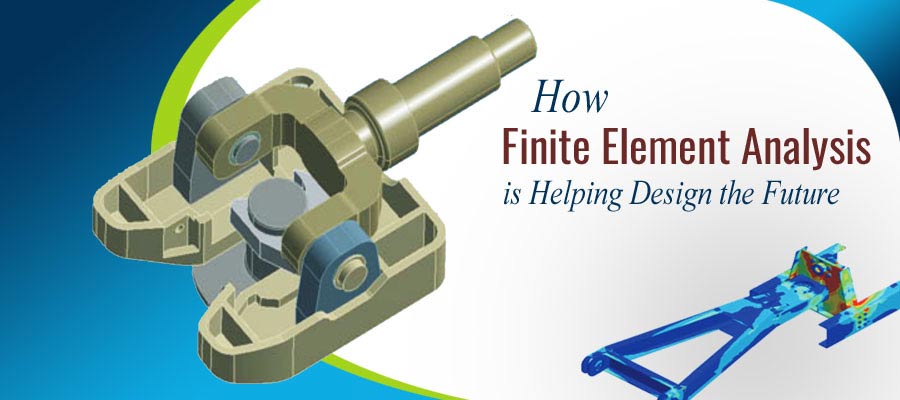How Finite Element Analysis is Helping Design the Future
Posted by Bhaumik Dave on September 12th, 2016

People often wonder how engineering marvels like the Boeing’s 787 Dreamliner, consisting of a massive 50,000 horsepower engine, made up of 18,000 complex parts is brought to life. While it takes a plethora of tools and technologies to bring such state-of-the-art, super-efficient aircraft in the market, there is one significant tool that outshines the rest – Finite Element Analysis (FEA). With its capabilities to optimize designs before even the first prototype is built, FEA or the Finite Element Method (FEM) has played a critical role for Rolls Royce to develop such a massive and highly efficient engine for the Dreamliner project.
Rolls-Royce utilized FEA to conduct different studies to understand critical design aspects of engine components like stress, structural strength, fatigue life, dynamics, thermo-mechanical effects, aeromechanics and much more. As a matter of fact, FEA is one of the important technical capabilities for Rolls-Royce, apart from CAD (Computer Aided Design).
FEA Methodology
Finite element method is in use since early 60s, and today, it has grown and become more robust to become an integral part of product design globally. This CAE (Computer Aided Engineering) technique is utilized across major industries like oil and gas, automotive, aerospace, construction, industrial equipment as well as biomedical and textile. There are several commercial software packages available today that are utilized across the globe, including ABAQUS, ANSYS, NX, Nastran, etc. While these tools may differ slightly in terms of technological capabilities, the core principle is still the same.
The first step of FEA involves developing a digital model of the geometry to be actually developed for the purpose of analysis. In the next step, the geometry is broken up into large number of small elements, consisting of shapes of cubes or prisms. Each element is assigned material properties and the entire model is assigned with boundary conditions in terms of forces or loads.
One the boundary conditions are assigned, the finite element solver solves the mathematical equations to predict the behavior of each element. Numerical methods are then utilized to combine the overall behavior of the actual model and stresses, vibration, displacement, temperature and heat transfer effects are calculated.
FEA is an Integral Part of Product Design
The use of FEA has become profound in the engineering world today, and even mechanical engineering students utilize tools like ANSYS during their academic studies. There are already efforts made by universities by partnering with leading FEA companies to train engineers of future.
Programs like PACE (Partners for the Advancement of Collaboration Engineers), involves universities from 10 different countries across the globe in collaboration with General Motors (GM) and other engineering companies like Siemens, Autodesk, ANSYS, Mathworks and DS Simulia. The program enables students to work with multinational teams and design automobiles for the future generations. They utilize FEA to evaluate the structural strength of their design under different conditions.
Problems with FEA
FEA can also turn your entire design a big failure, if the element selection is improper or boundary conditions are not applied properly. The results can be drastic; from excessive noise and vibration and excessive wear of the component to early failure, causing a hazardous situation.
It is important thus to understand that finite element method provides only the results based on what data you provide as an input. As such, the prime responsibility of the user is to completely understand the product behavior in real world and other properties and conditions. FEA is an approximation method and imperfections will always be present. Thus, the best way is then to validate the results obtained through FEA experimentally.
Diverse Applications of FEA
Although there are limitations, finite element method is playing a significant role in the design of biomedical parts like prosthetic limbs or implants for spinal fusion. FEA is also used to examine the human heat in order to design better pacemakers and arterial stents, so that open heart surgery can be avoided. Its use is also in many other unexpected industries like in analyzing the behavior of fabrics in manufacturing undergarments, so that they can remain more supportive and comfortable for the wearer. One of the notable uses of FEA was by the NIST (National Institute of Standards and Technology) to perform investigation studies in the tragic collapse of World Trade Center during the terrorist attacks on 9/11.
FEA to Design the Future
FEA holds a promising future for product engineering design, and is being increasingly refined to improve the solver capabilities in predicting the behavior more accurately. With further developments in High Performance Computing (HPC), future finite element solvers are expected to become more reliable and eliminate the use of physical tests at many levels.


